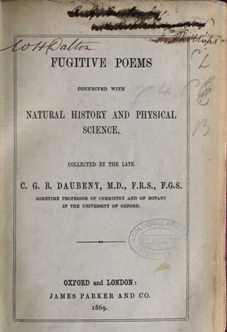 He who with pocket-hammer smites the edge
He who with pocket-hammer smites the edge
Of luckless rock or prominent stone, disguised
In weather-stains or crusted o'er by Nature.
The substance classes by some barbarous name,
And thinks himself enriched,
Wealthier, and doubtless wiser than before.
These lines, from William Wordsworth’s The Excursion (1814), caused some offence among geologists of the time. Adam Sedgwick, who had been acquainted with the poet during various rambles in the Lake District, wrote in a letter to Wordsworth that the lines were ‘a poetic ban against my brethren of the hammer’
1 Wordsworth tried to wriggle out of the charge by claiming it was the character in the poem that possessed such opinions (and, perhaps digging a deeper hole for himself, insisted his attack was not on geologists, but mineralogists!
2)
This was a period when debates of a varying nature between artists and scientists were commonplace, and the distinction between scientific and artistic pursuits less pronounced than today. In the Library’s Rare Books collection, self-penned poems are abundant: as prefaces, as musings from the field, as dedications, or, in the case of John Bakewell’s A geological primer in verse (1820) and J.S. Watson’s Geology. A Poem in Seven Books (1844), as epic geological histories of the world laid out in rhyming couplets.
One book that fights the ‘poetic ban’ with great fervour is Charles Daubeny’s Fugitive poems…. In the latter years of his life Daubeny began to collect ‘some of the many effusions which from time to time had emanated from the prolific pens of his friends, hoping thus to preserve for the world their witty and instructive thoughts’
3. The 71 poems in the anthology are indeed witty, from ‘Ode to a Professor’s Hammer’ by William Conybeare, to Horatio Smith’s nightmarish vision of Gideon Mantell’s museum, and Daubeny’s own ‘Lecture on Economical Cookery’. Many were written to be sung at the gentlemen’s gatherings.
But they are at the same time instructive, from elegies for figures such as William Buckland and William Smith, to John Stuart Blackie’s ‘The Boulder’, which marvels on the journey of an erratic, and the aforementioned Bakewell’s ‘The Birth of Granite’, which personifies Granite, Silex, Felspar and Mica in order to teach their properties to students. My favourites, however, are William Whewell’s tightly wrought sonnets, and Edward Forbes’s funny yet touching romance ‘A Naturalist’s Valentine’, a subtly formed metaphor of love lost across geological time: ‘Like some fantastic trilobite,/That perished in Silurian sea,/And long lay hid from mortal sight,/So was the heart I yield to thee’.
GEOLOGY & POETRY EVENT
Daubeny hoped that through publication of his anthology, ‘Literature and Science may be made to join hands in furnishing some amusement and some instruction’
4. It is with similar pursuits in mind that the Society’s current President, Bryan Lovell, proposed in last July’s
Geoscientist an event at which ‘the best geological poetry, original or otherwise… be judged by literary celebrities at an evening of high culture at Burlington House – with appropriate refreshment.’
Lovell now takes particular pleasure in inviting Fellows, Friends and other interested parties to a
free one day celebration of poetry and geology at the Geological Society on
Monday 10 October 2011. For more information and to register a place, visit
www.geolsoc.org/geopoetry or contact
Georgina Worrall in the Conference Department.
REFERENCES
- Wordsworth, William et al. A complete guide to the Lakes, comprising minute directions for the tourist, with mr. Wordsworth's Description of the scenery of the country, &c. and Three letters upon the geology of the Lake district, by prof. Sedgwick London: Longman & Co., 1842
- Davies, Hunter A walk around the lakes. A visit to Britain’s Lake District London: Frances Lincoln Ltd., 2009 (4th Edition).
- Daubeny, C.G.B. Fugitive poems connected with natural history and physical science London: James Parker & Co., 1869
- Ibid.
- The Library operates a sponsorship scheme to help preserve and restore its rare books. For more information, contact Michael McKimm in the library, or see the Sponsor A Book page on the Society’s website: www.geolsoc.org.uk/sponsorabook